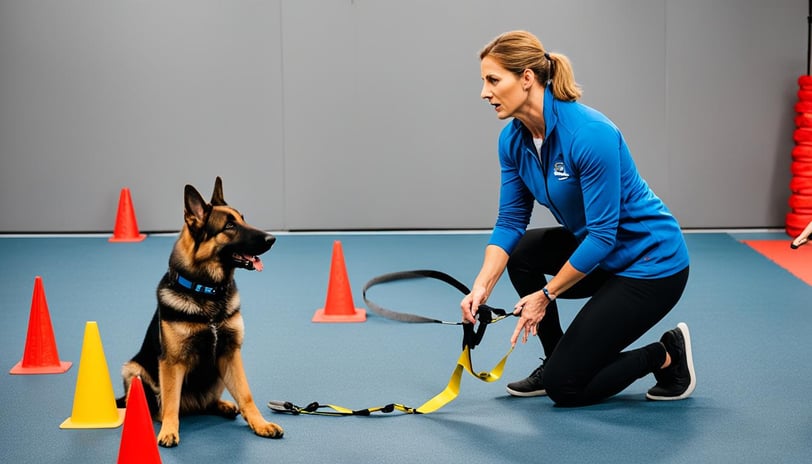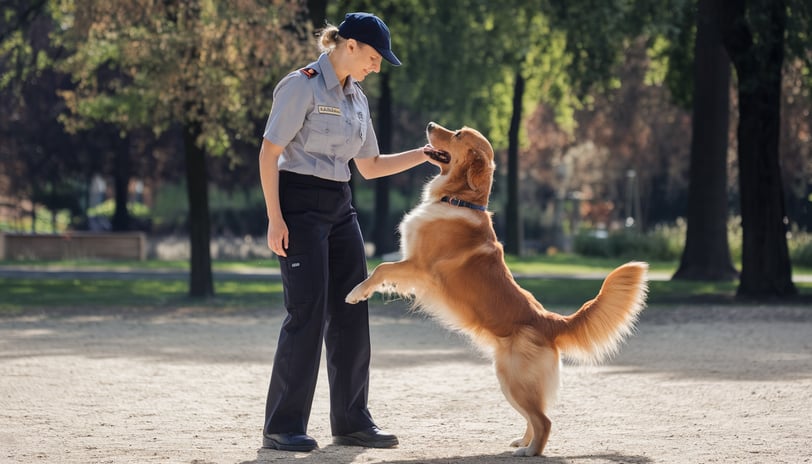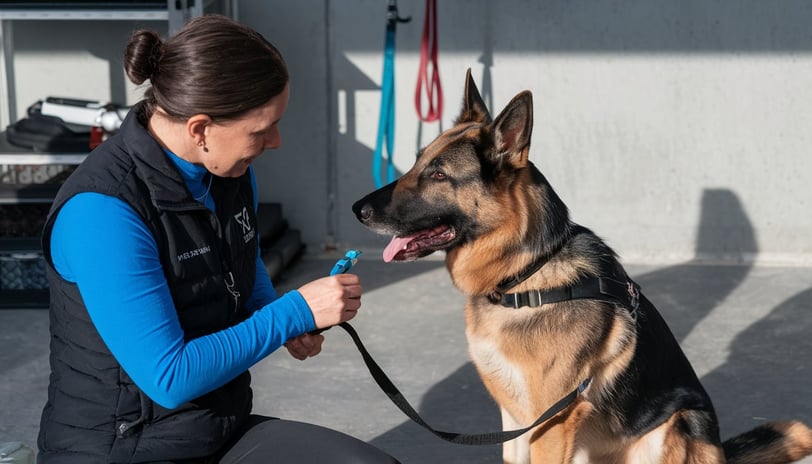Dog training techniques for beginners: Techniques, Tips, and Solutions
Discover the ultimate guide to dog training, packed with expert techniques, practical tips, and solutions for common behavioral issues. Learn how to effectively communicate with your furry friend, establish good habits, and build a strong bond through positive reinforcement. Whether you're a new or experienced dog owner, this comprehensive resource has everything you need to raise a well-behaved and happy canine companion.
The Canine Chronicles
8/21/20245 min read


Are you struggling with dog training? You're not alone!
Many pet owners find it challenging to teach their furry friends good behavior.
But don't worry, this ultimate guide will provide you with practical advice, useful techniques, and expert insights to ensure your dog becomes a well-behaved member of your family.
Whether you're a first-time dog owner or have experience in training, this comprehensive resource will answer your questions and help you build a strong bond with your canine companion.
Why Dog Training is Essential
Before we dive into the nitty-gritty of dog training, let's discuss why it's so important:
Enhances communication: Training helps you understand your dog's needs and teaches them to respond to your commands, leading to better communication between you and your pet.
Prevents behavior issues: By teaching your dog good manners and obedience, you can prevent common behavior problems like excessive barking, chewing, and aggression.
Builds a strong bond: Training sessions are an excellent opportunity to spend quality time with your dog, strengthening the bond between you and fostering trust and respect.
Basic Principles of Dog Training
1. Understanding Your Dog's Behavior
To effectively train your dog, you need to understand their behavior and what motivates them. Here are some key things to keep in mind:
Body language: Dogs communicate through body language, so it's essential to learn how to read your dog's signals. A wagging tail, for example, doesn't always mean a happy dog.
Reasons for misbehavior: Dogs often misbehave due to boredom, fear, or lack of exercise. Addressing these underlying issues can help solve behavior problems.
2. Training Methods
There are various training methods, but positive reinforcement is the most effective and humane approach. Here's how it works:
Positive Reinforcement
Using treats and praise: Whenever your dog performs a desired behavior, reward them with a treat and verbal praise. This reinforces good behavior and encourages them to repeat it.
Examples of success: For instance, if you're teaching your dog to sit, give them a treat and say "Good boy/girl!" as soon as their bottom touches the ground.
Negative Reinforcement
Understanding corrections: Negative reinforcement involves removing something unpleasant when your dog performs the desired behavior. For example, if your dog is pulling on the leash, you can stop walking until they calm down and loosen the leash tension.
3. Using Command Cues Effectively
Consistency is key when using command cues. Here are some tips:
Teaching basic commands: Start with simple commands like "Sit," "Stay," and "Come." Use clear, concise words and always use the same command for the same behavior.
One command at a time: Focus on teaching one command at a time to avoid confusion. Once your dog has mastered a command, you can move on to the next one.


Housetraining Tips
Housetraining is one of the first things you'll need to teach your new puppy or dog. Here are some tips to make the process easier:
Establish a routine: Take your dog out to potty at regular intervals, especially after meals, naps, and playtime.
Supervise closely: Keep a close eye on your dog when they're inside and watch for signs that they need to go, such as sniffing, circling, or whining.
Crate training: A crate can be a useful tool for housetraining as dogs generally don't like to soil their sleeping area. Just make sure the crate is the right size and never use it as punishment.
Leash Training Techniques
Leash training is essential for your dog's safety and your own peace of mind. Here are some techniques to try:
Start inside: Begin leash training inside your home where there are fewer distractions. Let your dog get used to wearing a collar and leash before venturing outside.
Use positive reinforcement: Reward your dog with treats and praise when they walk calmly beside you on a loose leash.
Avoid common mistakes: Don't yank on the leash or allow your dog to pull you. If they start pulling, stop walking and wait for them to return to your side before continuing.
Socialization Strategies
Socialization is the process of exposing your dog to new people, animals, and environments to help them become well-adjusted and confident. Here are some strategies to try:
Start early: The critical socialization period for puppies is between 3 and 16 weeks old, so it's important to expose them to a variety of experiences during this time.
Take it slow: Introduce new experiences gradually and at your dog's pace. Don't force them into situations that make them uncomfortable.
Make it positive: Pair new experiences with things your dog enjoys, like treats or playtime, to create positive associations.


Addressing Common Behavioral Issues
Even with the best training, behavioral issues can still arise. Here are some common problems and how to address them:
Barking: Teach your dog the "Quiet" command and reward them for being calm. You can also try to identify and remove the trigger for the barking, such as closing the curtains if they bark at passersby.
Chewing: Provide plenty of appropriate chew toys and supervise your dog closely. If you catch them chewing on something off-limits, redirect them to a toy and praise them for chewing on it instead.
Separation anxiety: Start by leaving your dog alone for short periods and gradually increase the duration. You can also try using puzzle toys or treat-dispensing toys to keep them occupied while you're gone.
Advanced Training and Enrichment
Once your dog has mastered the basics, you can move on to more advanced training and enrichment activities:
Teach tricks: Training your dog to perform tricks like "Roll over" or "Play dead" is a fun way to bond with your pet and impress your friends.
Try dog sports: Sports like agility, flyball, and nosework provide mental and physical stimulation for your dog and can be a great way to bond with your pet.
Provide enrichment: Puzzle toys, snuffle mats, and other enrichment activities can help keep your dog's mind active and prevent boredom.
FAQ
How long does it take to train a dog?
The length of time it takes to train a dog varies depending on factors like the dog's age, breed, and individual personality. However, with consistent training sessions and positive reinforcement, most dogs can learn basic obedience commands within a few weeks to a few months.
What if my dog doesn't respond to training?
If your dog isn't responding to training, there could be several reasons why. They may be distracted, confused, or not motivated enough. Try using higher-value treats, removing distractions, or breaking the behavior down into smaller steps. If you're still having trouble, consider working with a professional dog trainer.
Conclusion
Dog training is an essential part of responsible pet ownership. By using positive reinforcement techniques, understanding your dog's behavior, and providing plenty of socialization and enrichment, you can help your furry friend become a well-behaved and happy member of your family. Remember to be patient, consistent, and always keep training sessions fun and rewarding for both you and your dog.
Sources and Further Reading
The Humane Society of the United States. "Dog Training Tips"
American Kennel Club. "Dog Training: Obedience, Tricks, Sports, and More"
https://thek9chronicles.com/complete-guide-to-puppy-training
Thanks and best regards
The Canine Chronicles
Click the link below and get your guide on how to train your dogs brain.
Click here and train your dogs brain.
This post may contain affiliate links. If you make a purchase through one of these links, we may earn a small commission at no additional cost to you. We only recommend products and services that we have personally used and believe will add value to our readers. Your support helps us continue to provide valuable content. Thank you for your support!
